Spinning? How About the Fan?
Initially pulled the battery from the Scout to get the flathead spinning, to test it. Not enough juice; not even after rapid charging it for a while. Tried the battery charger itself, in "start" mode (55 amps). Enough juice to spin the starter off the motor, but apparently not enough to turn the motor when installed. Futzed around for a while, and just got hot tired and frustrated, so took a break and mocked up fan arrangements. First photo below shows one arrangement with bungee cords serving as fan belts. Some funny alignment issues going on, perhaps more apparent in the second photo, sans cords. The double crank pulley in the first picture is the '49-'53 truck pulley I got yesterday, to check dimensions between the front and rear pulleys, relative to my generator, water pump, and fan locations. Savvy Ford folks may recognize in the second photo that I've turned the fan carrier around, to see if it would pull the fan closer to the block, to work with the late double pulley. It did, but only kinda.
Fan Mock-up with Bungee "Belts"
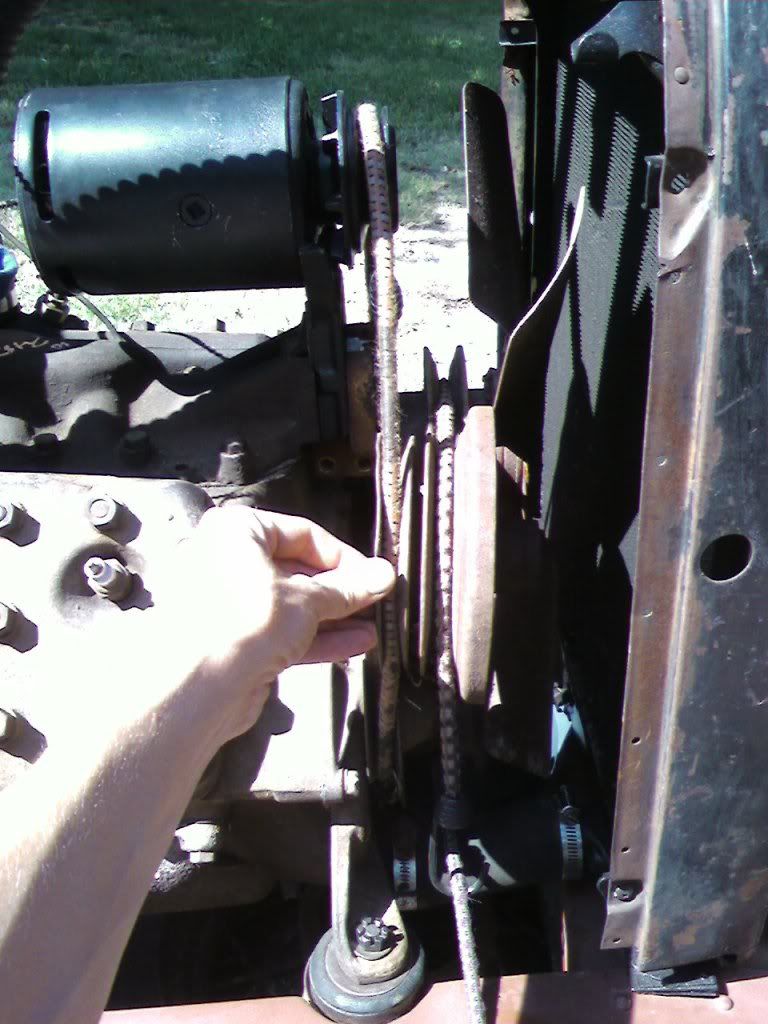
Fan Mock-up Less "Belts"
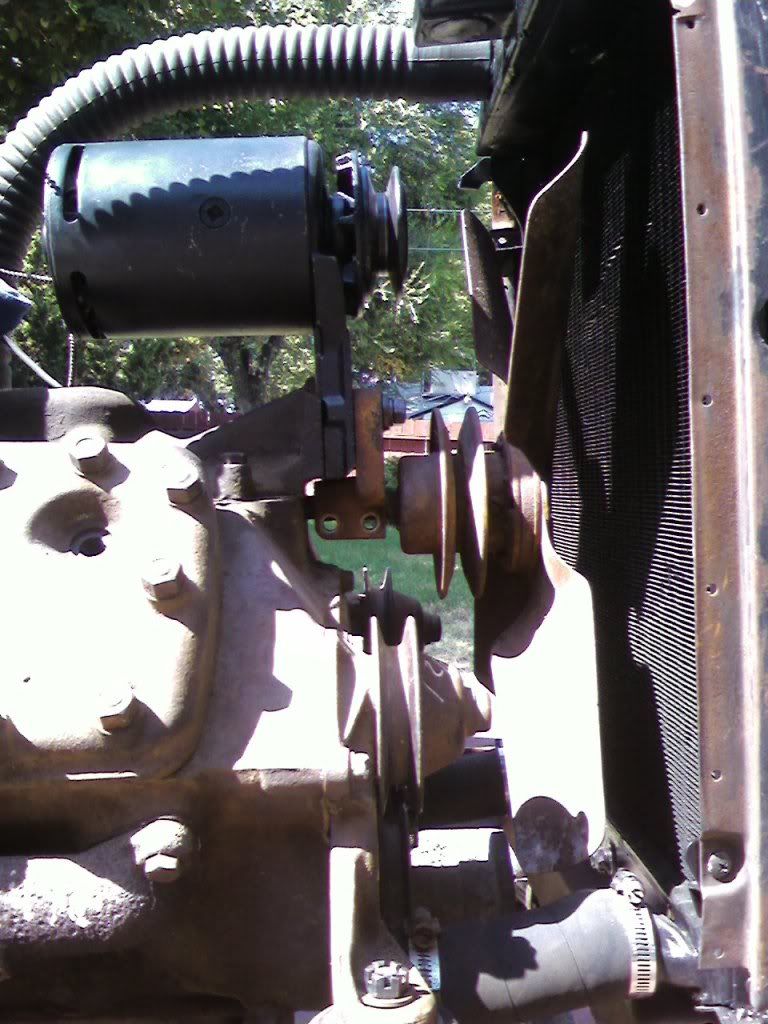
As I was doing this, however, I realized (duh) that the radiator location on my test frame is closer to the block than it will be on Twice Lucky's frame, and that I should relocate the radiator back on Lucky, meaning that most of the work I'd just done was relatively in vain, BUT it made me realize I have a lot more room in Lucky's frame, which made me think of this part that I'd photo-documented in my friend's junk pile yesterday: a '42-'48 passenger crank pulley.
Passenger Double Pulley
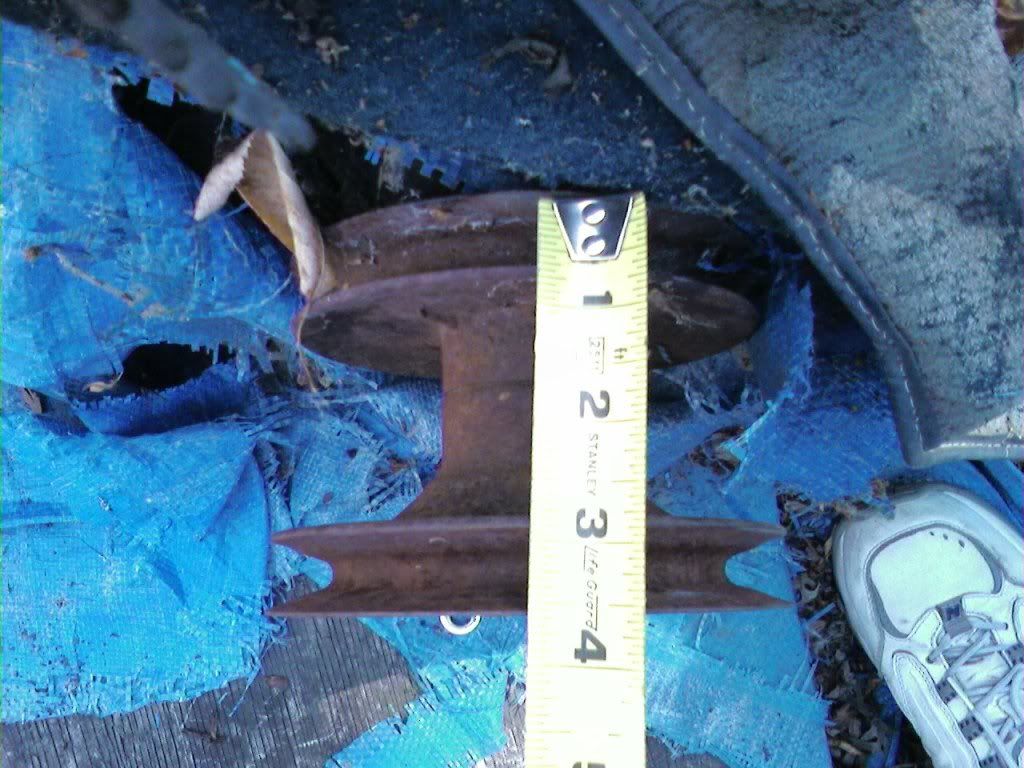
This pulley has what appears to be about 2-7/8" between pulleys, which I can accommodate in Lucky's frame, AND it puts the fan very (but not dangerously) close to the radiator, which should give me good draw, considering I won't be running a hood. Here's me mocking up the fan assembly, with the approximate spacing shown in the previous picture.
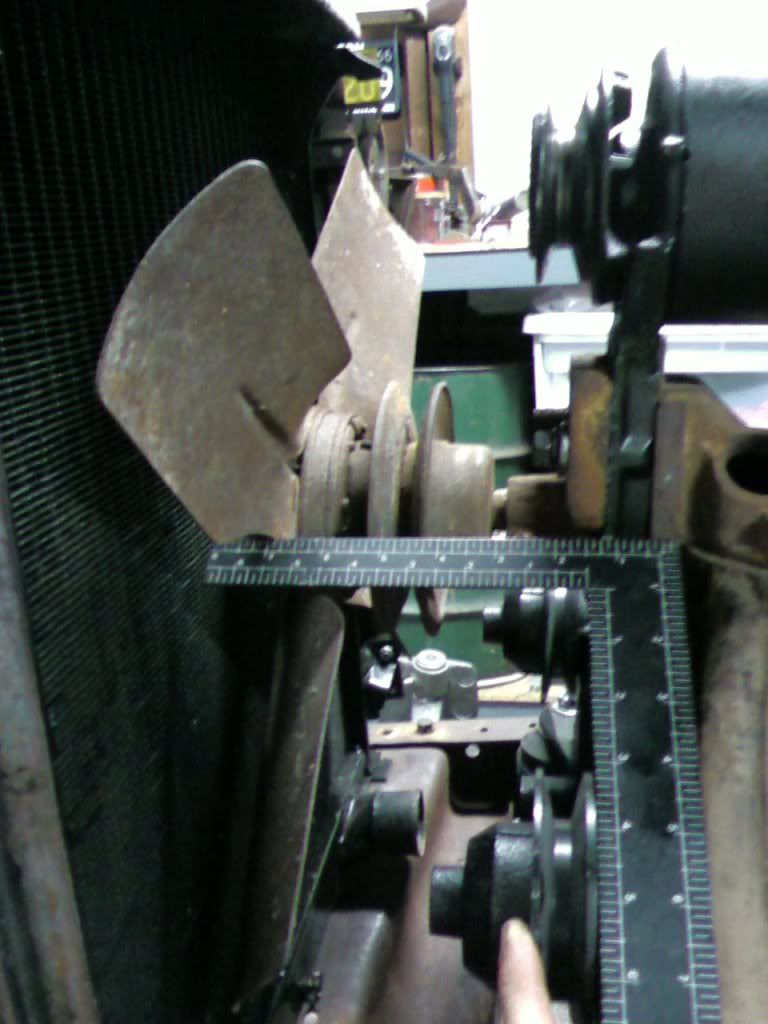 This means I'll basically be running the fan as it would've been stock on the '42-'48 Ford passenger vehicles. We'll see how this goes once I get the actual engine in Lucky, since this is just the bare block I'm using to mock things up.
This means I'll basically be running the fan as it would've been stock on the '42-'48 Ford passenger vehicles. We'll see how this goes once I get the actual engine in Lucky, since this is just the bare block I'm using to mock things up.Compression Testing
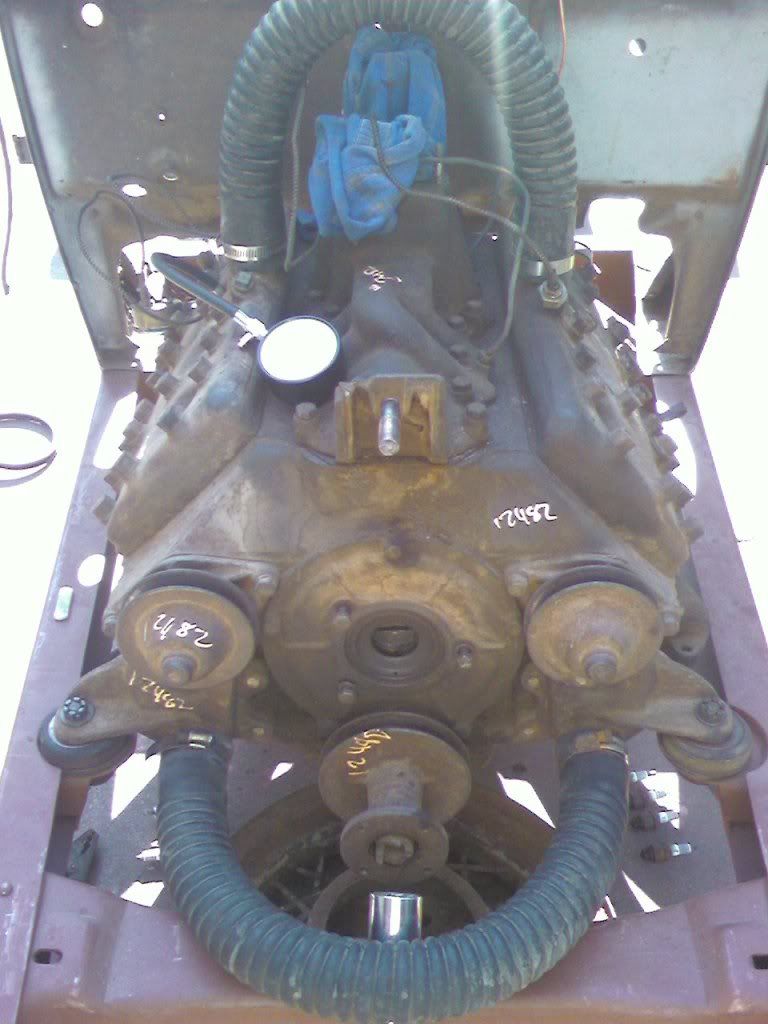 Here's a terrible image I shot after I'd removed the radiator and Okie-rigged the water fittings to keep water in the block since the radiator went back on Lucky. You can see how bright (hot) it was out there while I was working. After fooling with the fan in the somewhat cooler garage, I returned to the motor, to do some oil pressure and compression testing. What's not detailed here is my midday escape from the project to 1) get lunch 2) get my uncle's battery charger with more amps to spin the motor, and 3) take a breather and get some well-needed advice from my uncle why I was having trouble getting the motor to turn. The short answer is: not enough juice. Even at 200 amps, his charger is a third of what my battery will deliver - ONCE it's charged up! So I got back to the motor with his charger while my charger tended my battery.
Here's a terrible image I shot after I'd removed the radiator and Okie-rigged the water fittings to keep water in the block since the radiator went back on Lucky. You can see how bright (hot) it was out there while I was working. After fooling with the fan in the somewhat cooler garage, I returned to the motor, to do some oil pressure and compression testing. What's not detailed here is my midday escape from the project to 1) get lunch 2) get my uncle's battery charger with more amps to spin the motor, and 3) take a breather and get some well-needed advice from my uncle why I was having trouble getting the motor to turn. The short answer is: not enough juice. Even at 200 amps, his charger is a third of what my battery will deliver - ONCE it's charged up! So I got back to the motor with his charger while my charger tended my battery.Results: Passenger Bank, 4-3-2-1 (L-R)
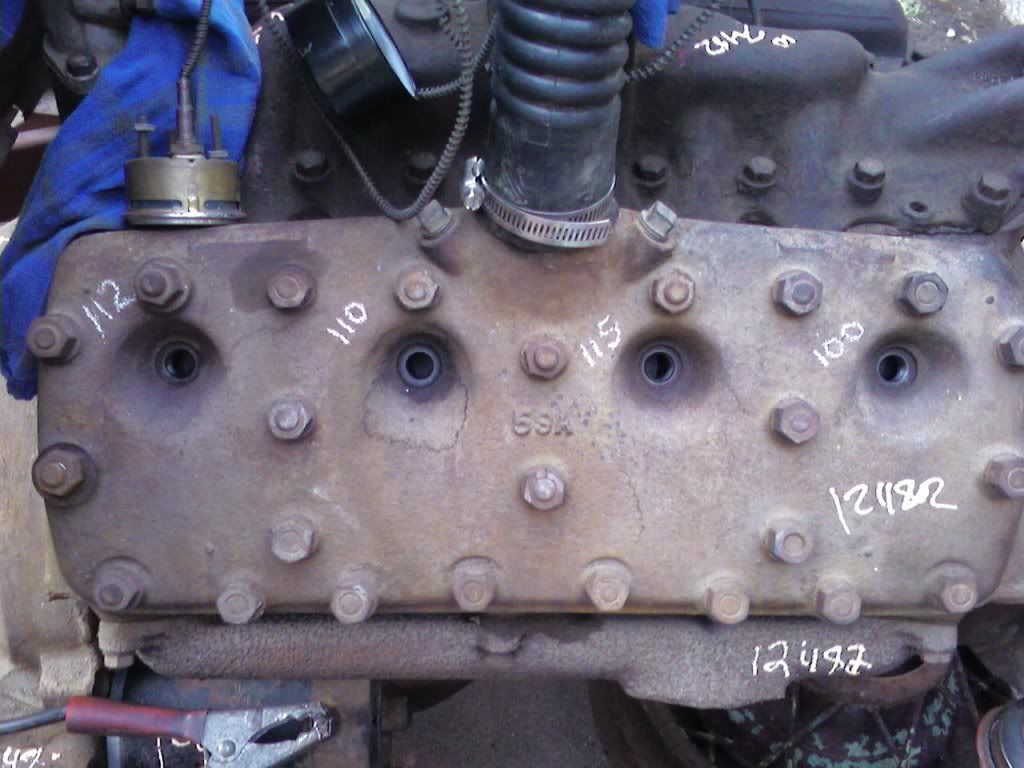 Results: Driver Bank, 5-6-7-8 (L-R)
Results: Driver Bank, 5-6-7-8 (L-R)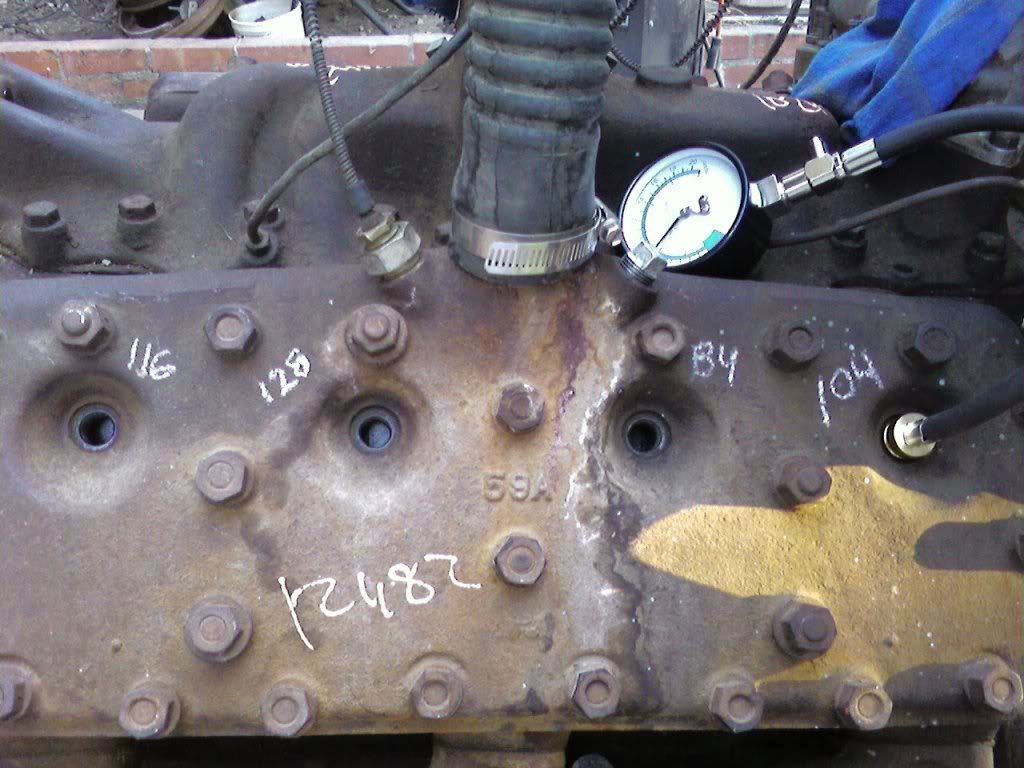
Flatheads aren't numbered like modern cars, hence the numbering you see above. You can also see the results I chalked above each cylinder. It was a trying process. First, it took me a bit to realize I'd popped the house circuit breaker when I changed chargers. Then, the 200 amp charger would only spin the starter on the motor after I'd manually cranked it past the "compression" cycle on the cylinder I was compression testing. Additionally, I never got oil pressure. I tested the gauge (good), blew out the line (clear) and spun the motor without these attached (gusher of oil a la the Clampetts) but apparently wasn't spinning the motor enough to get continuous pressure to the gauge. Oh, well, I know from the oil it gushed that the pump is working.
So, as you can see from the results, compression was high and pretty consistent except for #7, even after adding oil to the cylinder to test the rings. That means a valve may not be closing all the way. No surprise there. This was the cylinder that had rust and crap down the intake port, meaning it probably got water down the carb at some point. But nothing that some Marvel Mystery Oil and some running shouldn't resolve, and if not, it's still pretty good compression. In fact, in checking my results against a tune-up spec sheet, I believe even more firmly that I have a "99T" or '39-'41 truck (100 hp) motor. It's running 59A (post-war) heads that, for all I know, were milled to raise compression, hence my higher readings. I think I already mentioned the adjustable lifters it's got - I think it's a former hot rod motor that later served time in the farm truck; I noticed a little remnant of (hot rod?) red on the intake today. I'd love to know its history, and I think I have enough bits of the story to track it down but, alas, I digress.
So, finally, I feel confident enough about the motor's condition after today's testing to go get the supplies I need tomorrow to start it. I wonder if I can get my uncle to help me and, perhaps more importantly for you, reader: shoot video of it running?
-30-





No comments:
Post a Comment